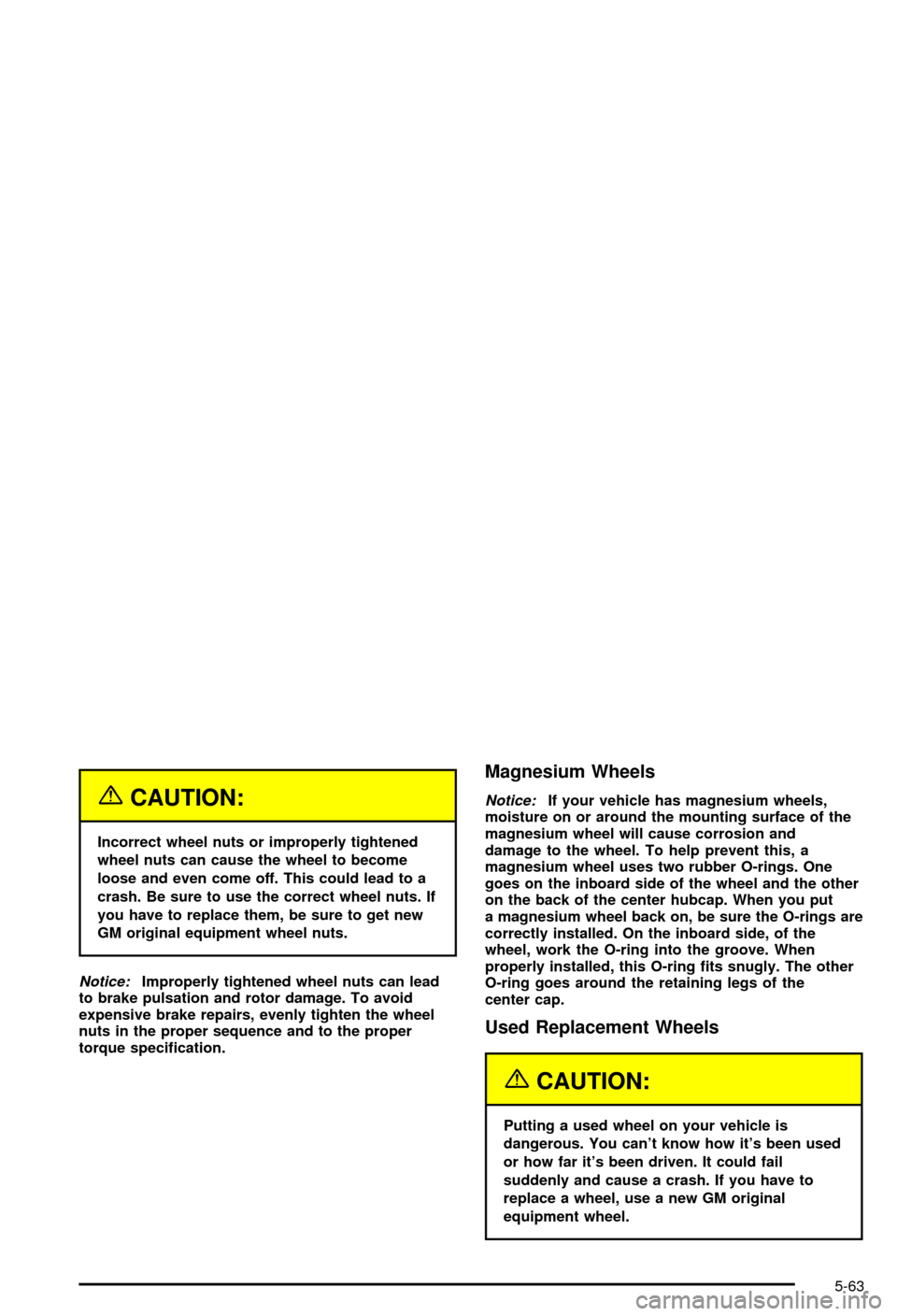Page 82 of 368

NEUTRAL (N):In this position, your engine doesn't
connect with the wheels. To restart when you're already
moving, use NEUTRAL (N) only. Also, use
NEUTRAL (N) when your vehicle is being towed.
{CAUTION:
Shifting into a drive gear while your engine is
ªracingº (running at high speed) is dangerous.
Unless your foot is ®rmly on the brake pedal,
your vehicle could move very rapidly. You
could lose control and hit people or objects.
Don't shift into a drive gear while your engine
is racing.
Notice:Damage to your transmission caused by
shifting out of PARK (P) or NEUTRAL (N) with
the engine racing isn't covered by your warranty.
AUTOMATIC OVERDRIVE (
X): This position is
for normal driving.
THIRD (3):This position is also used for normal driving.
However, it offers more power and lower fuel economy
than AUTOMATIC OVERDRIVE (
X).Here are some times you might choose THIRD (3)
instead of AUTOMATIC OVERDRIVE (
X):
·When driving on hilly, winding roads.
·When going down a steep hill.
SECOND (2):This position gives you more power but
lower fuel economy than THIRD (3). You can use
SECOND (2) on hills. It can help control your speed as
you go down steep mountain roads, but then you
would also want to use your brakes off and on.
If you manually select SECOND (2) when you start the
vehicle, the transmission will drive (and stay) in
second gear. You may use this feature for reducing
torque to the rear wheels when you are trying to start
your vehicle from a stop on slippery road surfaces, or for
preventing the transmission from downshifting into
FIRST (1) in situations where a downshift would
be undesirable.
FIRST (1):This position gives you even more power,
but lower fuel economy, than SECOND (2). You can use
it on very steep hills, in deep snow or mud. If the shift
lever is put in FIRST (1), the transmission won't shift into
®rst gear until the vehicle is going slowly enough.
2-26
Page 291 of 368

{CAUTION:
Incorrect wheel nuts or improperly tightened
wheel nuts can cause the wheel to become
loose and even come off. This could lead to a
crash. Be sure to use the correct wheel nuts. If
you have to replace them, be sure to get new
GM original equipment wheel nuts.
Notice:Improperly tightened wheel nuts can lead
to brake pulsation and rotor damage. To avoid
expensive brake repairs, evenly tighten the wheel
nuts in the proper sequence and to the proper
torque speci®cation.
Magnesium Wheels
Notice:If your vehicle has magnesium wheels,
moisture on or around the mounting surface of the
magnesium wheel will cause corrosion and
damage to the wheel. To help prevent this, a
magnesium wheel uses two rubber O-rings. One
goes on the inboard side of the wheel and the other
on the back of the center hubcap. When you put
a magnesium wheel back on, be sure the O-rings are
correctly installed. On the inboard side, of the
wheel, work the O-ring into the groove. When
properly installed, this O-ring ®ts snugly. The other
O-ring goes around the retaining legs of the
center cap.
Used Replacement Wheels
{CAUTION:
Putting a used wheel on your vehicle is
dangerous. You can't know how it's been used
or how far it's been driven. It could fail
suddenly and cause a crash. If you have to
replace a wheel, use a new GM original
equipment wheel.
5-63
Page 320 of 368
Capacities and Speci®cations
The following approximate capacities are given in English and metric conversions.
Please refer to
Part D: Recommended Fluids and Lubricants on page 6-14for more information.
Capacities and Speci®cations
ApplicationCapacities
English Metric
Air Conditioning Refrigerant R134a 1.75 lbs 0.79 kg
Automatic Transmission
Drain and Re®ll 5.0 quarts 4.7 L
Overhaul 10.8 quarts 10.2 L
Cooling System 12.6 quarts 11.9 L
Engine Oil with Filter 6.5 quarts 6.1 L
Fuel Tank 18.0 gallons 68.0 L
Manual Transmission (Overhaul) 4.1 quarts 3.8 L
Wheel Nut Torque 100 lb ft 140Y
All capacities are approximate. When adding, be sure to ®ll to the appropriate level, as recommended in this
manual. Recheck ¯uid level after ®lling
5-92
Page 367 of 368

Tires.............................................................5-54
Buying New Tires........................................5-59
Chains.......................................................5-64
Extended Mobility........................................5-54
If a Tire Goes Flat.......................................5-68
In¯ation -- Tire Pressure...............................5-56
Lifting Your Corvette....................................5-64
Pressure Monitor System..............................5-57
Rotation.....................................................5-58
Tire and Wheel Inspection............................6-12
Tire In¯ator Kit............................................5-70
Uniform Tire Quality Grading.........................5-60
Wheel Alignment and Tire Balance.................5-61
Wheel Replacement.....................................5-61
To Use The Engine Coolant Heater...................2-23
Top Strap Anchor Location...............................1-31
Top Strap......................................................1-30
Torque Lock (Automatic Transmission)...............2-33
Towing..........................................................4-33
Recreational Vehicle.....................................4-33
Towing a Trailer..........................................4-35
Your Vehicle...............................................4-33
Traction.........................................................4-10
Active Handling System................................4-10
Control System (TCS).................................... 4-9
Control System Warning Light.......................3-36
Limited-Slip Rear Axle..................................4-11
Selective Ride Control..................................4-12
Transmission Operation, Automatic....................2-24
Transmission Operation, Manual........................2-27Transmission..................................................5-20
Fluid, Automatic...........................................5-20
Fluid, Manual..............................................5-20
Transportation Options...................................... 7-8
Trunk/Hatch...................................................2-11
Trunk-Mounted CD Changer.............................3-71
Turn and Lane-Change Signals.......................... 3-6
Turn Signal/Multifunction Lever........................... 3-6
Twilight Sentinel
ž(Optional in United States,
Standard in Canada)....................................3-14
U
Underbody Flushing Service.............................6-11
Understanding Radio Reception........................3-77
Uniform Tire Quality Grading............................5-60
United States ± Customer Assistance.................. 7-4
Unlocking the Theft-Deterrent Feature After a
Power Loss................................................3-76
V
Vehicle Identi®cation........................................5-83
Number (VIN).............................................5-83
Service Parts Identi®cation Label...................5-83
Vehicle Personalization....................................2-55
Memory.....................................................2-55
Vehicle Storage..............................................5-40
13